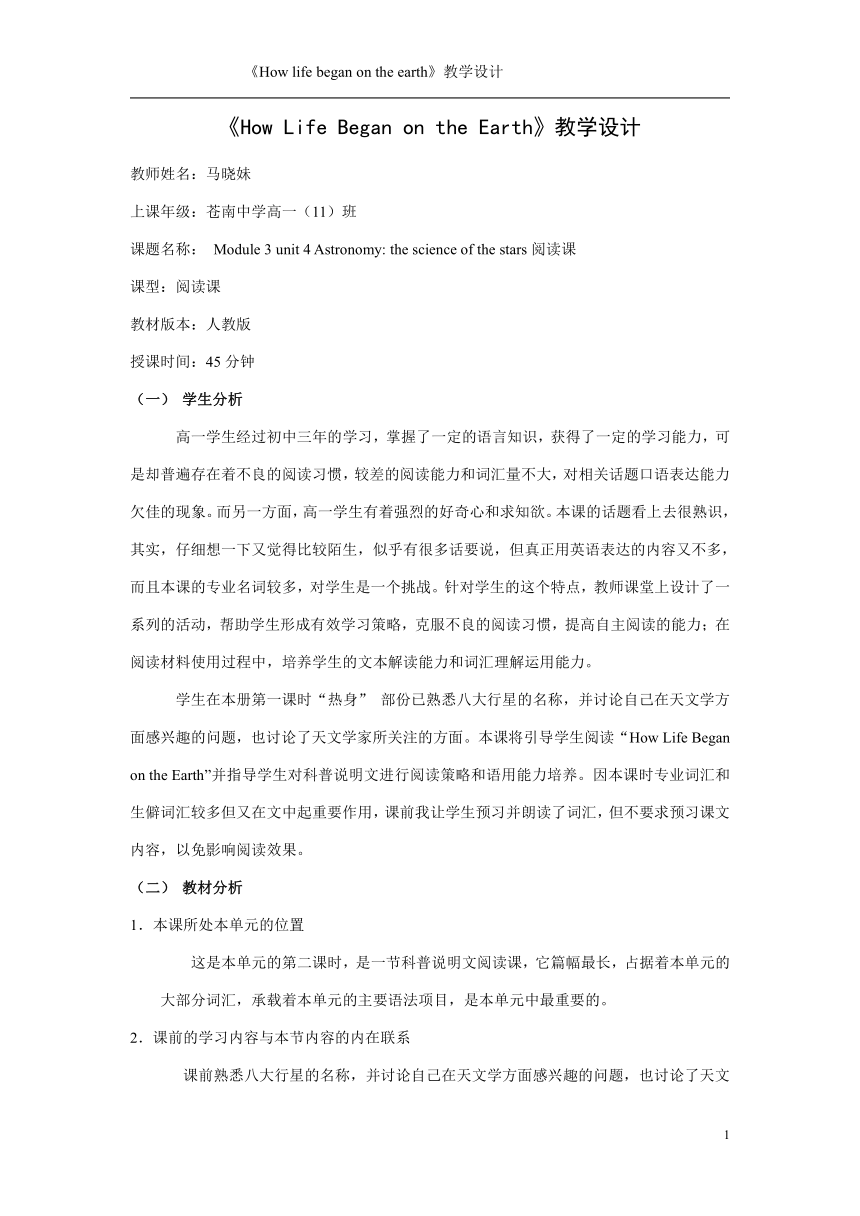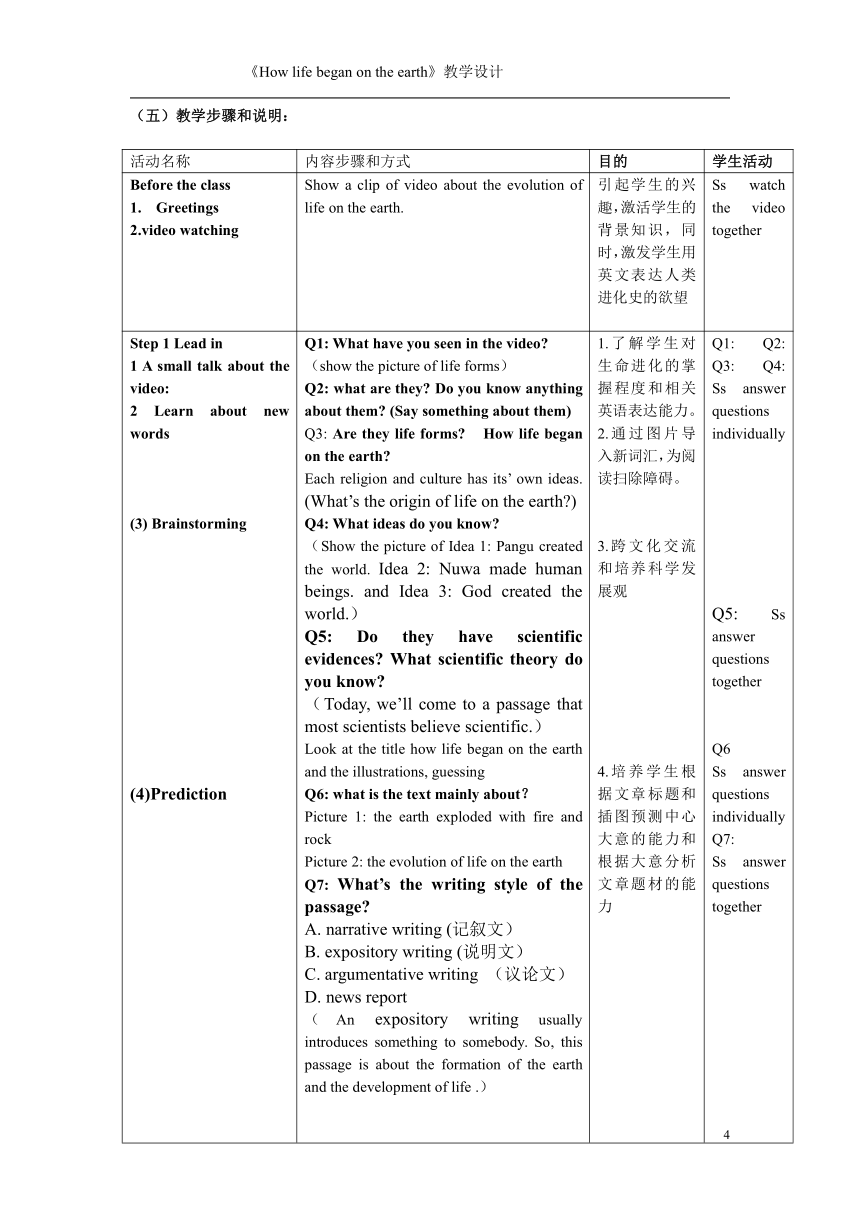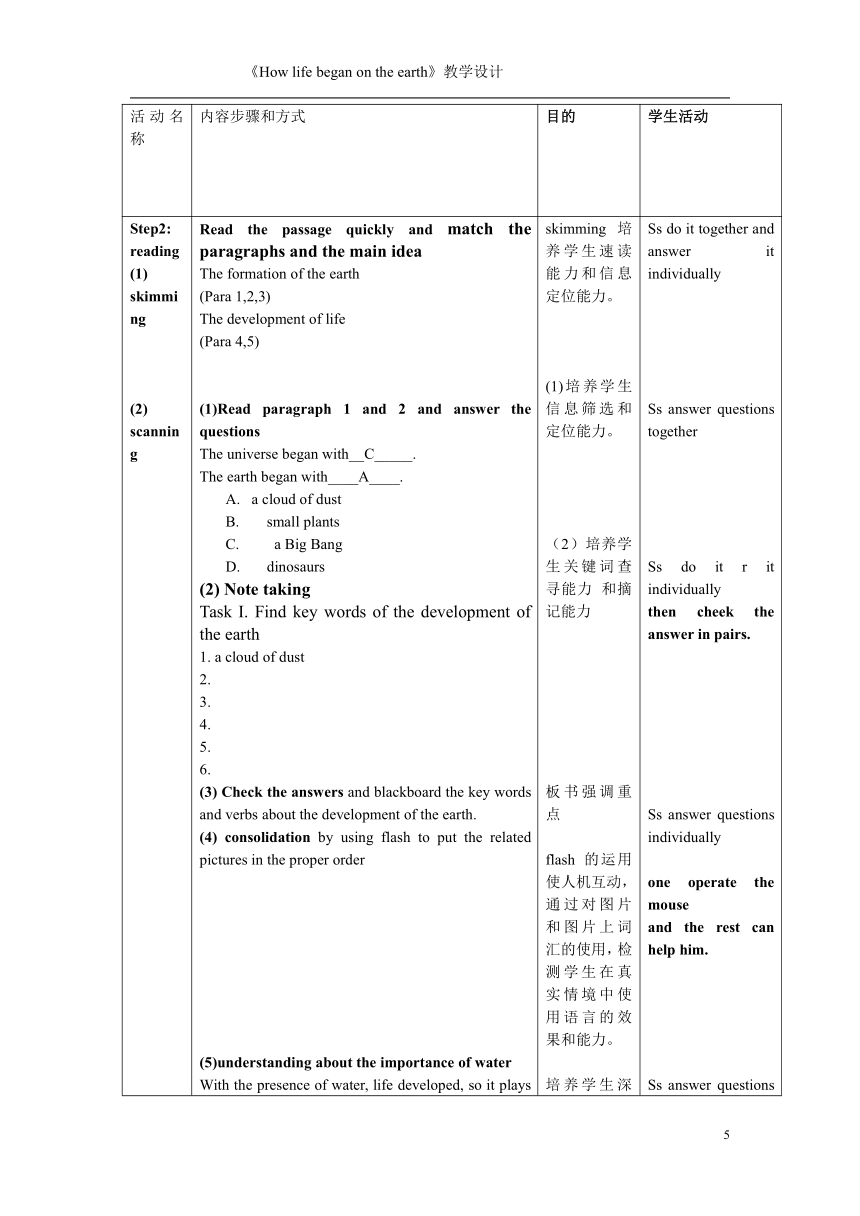必修三Unit 4 Astronomy: the science of the stars reading 教学设计
文档属性
| 名称 | 必修三Unit 4 Astronomy: the science of the stars reading 教学设计 |

|
|
| 格式 | zip | ||
| 文件大小 | 21.2KB | ||
| 资源类型 | 教案 | ||
| 版本资源 | 人教版(新课程标准) | ||
| 科目 | 英语 | ||
| 更新时间 | 2013-05-10 06:27:15 | ||
图片预览





文档简介
《How life began on the earth》教学设计
《How Life Began on the Earth》教学设计
教师姓名:马晓妹
上课年级:苍南中学高一(11)班
课题名称: Module 3 unit 4 Astronomy: the science of the stars阅读课
课型:阅读课
教材版本:人教版
授课时间:45分钟
(1) 学生分析
高一学生经过初中三年的学习,掌握了一定的语言知识,获得了一定的学习能力,可是却普遍存在着不良的阅读习惯,较差的阅读能力和词汇量不大,对相关话题口语表达能力欠佳的现象。而另一方面,高一学生有着强烈的好奇心和求知欲。本课的话题看上去很熟识,其实,仔细想一下又觉得比较陌生,似乎有很多话要说,但真正用英语表达的内容又不多,而且本课的专业名词较多,对学生是一个挑战。针对学生的这个特点,教师课堂上设计了一系列的活动,帮助学生形成有效学习策略,克服不良的阅读习惯,提高自主阅读的能力;在阅读材料使用过程中,培养学生的文本解读能力和词汇理解运用能力。
学生在本册第一课时“热身” 部份已熟悉八大行星的名称,并讨论自己在天文学方面感兴趣的问题,也讨论了天文学家所关注的方面。本课将引导学生阅读“How Life Began on the Earth”并指导学生对科普说明文进行阅读策略和语用能力培养。因本课时专业词汇和生僻词汇较多但又在文中起重要作用,课前我让学生预习并朗读了词汇,但不要求预习课文内容,以免影响阅读效果。
(2) 教材分析
1.本课所处本单元的位置
这是本单元的第二课时,是一节科普说明文阅读课,它篇幅最长,占据着本单元的大部分词汇,承载着本单元的主要语法项目,是本单元中最重要的。
2.课前的学习内容与本节内容的内在联系
课前熟悉八大行星的名称,并讨论自己在天文学方面感兴趣的问题,也讨论了天文学家所关注的方面,这节课主要谈论地球上生命的起源,和师生生活息息相关,第一节课和这节课是宏观和微观的关系,整体和部分的关系。
3.对教材的处理
How life began on the earth 是《普通高中课程标准实验教科书》高一年级第二学期UNIT 4的第一篇阅读课文。“pre-reading”部分要求学生说说不同宗教,不同文化对生命起源的解释。通过读标题和图片预测课文的中心大意,并通过快速阅读查证自己的预测。“Reading”课文的第一部分主要讲述了地球的形成过程,第二部分主要讲述了地球的生命起源和发展历程,并提出因人类没有好好地保护地球而致使全球气候变暖,并引发对地球的将来如何的发问。“comprehending”部分设置了五个练习,练习一通过为每个段落总结中心大意,并分析文章的结构,检测学生的整体阅读和概括的能力以及初步认识语篇特征的能力。练习二通过排序的方式,帮助学生弄清本文的行文线索,也就是地球生命的起源和发展历程。练习三要求同伴讨论五个问题,考察学生的深层理解和推断能力,练习四从说明文的语言特点出发,要求学生找出“discourse makers 和sentence connections。练习五要求学生 read behind the line , 讨论找出本文深藏的几个让科学家难以解决的疑问并做些研究向全班汇报,激发学生对生物和天文学的探究。教材要求学生具备一定听说读写能力,让学生了解地球的形成过程和地球的生命起源和发展历程。如果一节课只是学习Reading 中的内容,学生对How life began on the earth的了解将会不太完整。根据学生的接受能力,我对本课的教材作了一些调整,即将本单元的“pre-reading”, “reading” 和“comprehending”合在一起构成“阅读课”,取消了“comprehending”练习五的活动,将练习一改编成对课文两个部分的概括,更加简洁明了,练习二对地球的形成过程和地球的生命起源和发展历程分开排序,设计了符合学生认知能力,由浅入深,更加活泼有趣互动的巩固练习,如flash的运用和真实语境的运用。练习四从说明文的语言特点出发,要求学生找出表示时间的词汇和不同动词对同一意思的表达,达到语言欣赏和分析的目的。
4.预测本节内容与设计对今后教学的影响
通过本文的学习,有利于学生用英语说明事物发展过程的能力,提高学生的科学素养。本设计是按照《英语课程标准》要求和根据学生的实际水平设计的,有针对性地培养学生的阅读能力,培养学生的文本解读能力和词汇理解运用能力。有利于学生的阅读策略,语言知识,语篇能力和语用能力的培养打好基础,也有利于教师今后更好地开展课堂教学。
(3) 教学目标
语言知识:通过阅读本文和老师的指导提示,在本课结束时,学生能正确理解本文内容,理解相关词汇的运用。
语言技能:学生在老师引导下,提高以下阅读技能和策略:预测,读图,跳读,寻读,摘记,排序,概括推理等。
学习策略:学生能够通过自己解决问题和小组讨论,同伴互助,个人自评和小组互评,培养自主探究学习策略和合作学习策略。
情感态度:学生通过参与活动激发学习热情,产生学习英语的浓厚兴趣,并学会用科学的眼光看待事物,养成科学探索精神,意识到保护地球,关爱生命的重要性。
(4) 教学策略
(1) 讨论法:激发思维,活跃气氛,让学生积极投入学习中。
(2) 图表归纳法:简明易懂,让学生更容易地掌握事物发展顺序
(3) 讲练法:在较短时间内掌握知识,形成技能技巧
(4) 任务驱动教学法:将所要学习的新知识隐含在任务中,学生通过对所提的任务进行分析、讨论,并在老师的指导和帮助下找出解决问题的方法,最后通过任务的完成而实现对所学知识的意义建构。
(5) 情境教学法:语言在用中学,在学中用
(6) 图示阅读教学法:根据学生的已有知识构建新的知识网络
教学辅助手段:计算机教学辅助,黑板,粉笔
计算机教学辅助手段调动学生积极性,让学生获得更多知识,同时能更快更容易地掌握内容,板书强调重难点,一目了然。
活动名称 内容步骤和方式 目的 学生活动
Before the classGreetings2.video watching Show a clip of video about the evolution of life on the earth. 引起学生的兴趣,激活学生的背景知识,同时,激发学生用英文表达人类进化史的欲望 Ss watch the video together
Step 1 Lead in1 A small talk about the video:2 Learn about new words(3) Brainstorming(4)Prediction Q1: What have you seen in the video (show the picture of life forms)Q2: what are they Do you know anything about them (Say something about them)Q3: Are they life forms How life began on the earth Each religion and culture has its’ own ideas. (What’s the origin of life on the earth )Q4: What ideas do you know (Show the picture of Idea 1: Pangu created the world. Idea 2: Nuwa made human beings. and Idea 3: God created the world.)Q5: Do they have scientific evidences What scientific theory do you know (Today, we’ll come to a passage that most scientists believe scientific.)Look at the title how life began on the earth and the illustrations, guessingQ6: what is the text mainly about?Picture 1: the earth exploded with fire and rockPicture 2: the evolution of life on the earth Q7: What’s the writing style of the passage A. narrative writing (记叙文) B. expository writing (说明文) C. argumentative writing (议论文)D. news report (An expository writing usually introduces something to somebody. So, this passage is about the formation of the earth and the development of life .) 1.了解学生对生命进化的掌握程度和相关英语表达能力。2.通过图片导入新词汇,为阅读扫除障碍。3.跨文化交流和培养科学发展观4.培养学生根据文章标题和插图预测中心大意的能力和根据大意分析文章题材的能力 Q1: Q2: Q3: Q4: Ss answer questions individuallyQ5: Ss answer questions togetherQ6Ss answer questions individuallyQ7:Ss answer questions together
(五)教学步骤和说明:
活动名称 内容步骤和方式 目的 学生活动
Step2: reading(1) skimming(2) scanning Read the passage quickly and match the paragraphs and the main idea The formation of the earth(Para 1,2,3)The development of life (Para 4,5)(1)Read paragraph 1 and 2 and answer the questionsThe universe began with__C_____.The earth began with____A____.a cloud of dust small plants a Big Bang dinosaurs (2) Note takingTask I. Find key words of the development of the earth1. a cloud of dust2. 3. 4.5. 6.(3) Check the answers and blackboard the key words and verbs about the development of the earth.(4) consolidation by using flash to put the related pictures in the proper order(5)understanding about the importance of waterWith the presence of water, life developed, so it plays an important role. In paragraph 3, which sentence tells it Why (6) the evolution of life on the earthRead from the illustration(插图)1. Did life appear on land or in the water first Why2. How did plants and animals develop 3. In what order is the development of life read paragraph 4&5, fill in the chart(见ppt)Check the answers and blackboard verbs, new words and words indicating time. Reading for speaking:M: Hi, Tom. I’m really confused about the development of life. What appeared first T: Well. It’s small plants that appeared first.M: Why was that T: They can produce oxygen, which…M: Next, what plants began to grow T…M: Later, when…T…M: After that…T…M: Finally…T…Consolidation:How Life Began On the Earth After the “Big Bang”, ______ began to form and slowly the dust settled into a solid ______. Then it exploded with fire and rock, which were to make the earth’s ___________. As the earth cooled down, water began to appear on its surface, which helped to dissolve harmful gases and _____. Later living things like plants, fish, insects, ____________, ________ appeared and developed. The disappearance of dinosaurs made possible the rise of __________ on the earth. Finally, some small clever animals with hands and feet appeared and they became the most important animals on the planet, that is, . skimming培养学生速读能力和信息定位能力。(1)培养学生信息筛选和定位能力。(2)培养学生关键词查寻能力 和摘记能力板书强调重点flash 的运用使人机互动,通过对图片和图片上词汇的使用,检测学生在真实情境中使用语言的效果和能力。培养学生深层理解的能力,同时引导学生形成严密的逻辑分析能力。培养学生文本解读能力,在阅读过程中学会采取适合文体特征的策略,同时“以图带文”,理清文字的脉络。图表归纳法:简明易懂,让学生更容易地掌握事物发展顺序板书补充课件的不足,将本文用不同动词介绍生命形式发展的语言特点表现出来,板书表示时间的词,突出写作顺序和特点。读说结合,达成学生在生活中使用英语的目的。巩固重难点,检测重要词汇的使用情况。同时培养学生的完形填空能力。 Ss do it together and answer it individuallySs answer questions togetherSs do it r it individuallythen cheek the answer in pairs.Ss answer questions individuallyone operate the mouse and the rest can help him.Ss answer questions togetherSs answer questions togetherfirst Ss do it t individuallythen cheek the answer in pairs.Ss do it in pairs.Ss do it r it individuallyand then read it loudly together.
Step3: after readingDiscussion: What will the future of the earth be like 拓展思维,延伸阅读主题,培养学生的探究,合作交流能力,于潜移默化中达到情感教育的目的 Ss do it in groups of 4 the group leader presentthe discussion.
Step4: Self-assessment(自我评价) Think about the passage and then complete the following form. Now rate yourself on a scale of five, one being low and five being high.(见学案) 培养学生自我反思和评价能力,养成学习策略。 Ss do it together and assess themselves individually after class
Home work 1. Finish Ex.4 on P27 in Student’s book.2. Go over the passage and pick out useful words and phrases.3. Surf the Internet about global warming. Ss do it r it individually
(六)课后反思
1.教学特色和教学成功方面
(1). 文本挖掘深刻,立体。充分利用文本特征(字号和字体,主题词,线条,方框,说明,插图,)功能设计读前,读中,读后三个环节的教学活动,帮助学生更好地掌握略读,寻读,预测,推理,分析,理解,评价等基本阅读技能,进而提高阅读能力。
(2).阅读中的词汇教学有效,方式多样灵活,从视频的导入呈现了生命形式和进化过程,激活学生对这些词汇的急切学习,进而用图片引导学生讲述跟生命形式有关的信息,接着引导学生在阅读中理解相关词汇,设计了多种多样的词汇巩固和运用形式,非常自然地将词汇学习和阅读教学相结合。
(3).教学辅助工具相辅相成,幻灯的内容和板书的设计互为补充,相得益彰。多媒体的使用力求使教学生动活泼,做到既能激发学生的学习兴趣,又能提高教学效果。板书的设计是教学重点和难点一目了然,给学生留下深刻印象。
(4).教学过程由浅入深,层层递进,环环相扣。教学手段灵活多样。任务与任务之间有连贯性,设计的梯度合理,单个任务的活动也能做到由浅入深,顺利达到教学目的。这样能活跃课堂气氛,提高学生的学习兴趣,有利于帮助学生建立信心,从而积极、主动地参与课堂活动。
(5).阅读技能指导有度、有效、有针对性,有深度。本文侧重对说明文文体特征的分析,引导学生发展预测,读图,跳读,寻读,摘记,排序,概括推理等技能和策略,成功地达到阅读的目的,同时设计了“reading for speaking” “reading for thinking “ 等语言综合运用活动,最终达到学为用的目的。
2.调整和改进方面
(1)第一个环节导入部分 A small talk about the video应该给学生更多的机会,激活他们对生命进化的背景知识,同时为阅读步骤的理解会有更深更广的铺垫。
(2)读中细读地球上生命进化的过程前,教师引导学生对生命进化图分析和解读,其中问到一个问题“Why plants appeared before animals ”教师引导学生细读段落4,但是在此后的讲解中没有对这个问题进行确认。教师应该及时叫学生解答问题。
附
Students’ work sheet for reading of M3U4
Task I. Find key words of the development of the earth
1. a cloud of dust
2.
3.
4.
5.
6.
Task II. Find life forms in the development of life on the earth
words indicating time plants animals
Task III. Consolidation
How Life Began On the Earth
After the “Big Bang”, ______ began to form and slowly the dust settled into a solid ______. Then it exploded with fire and rock, which were to make the earth’s ___________. As the earth cooled down, water began to appear on its surface, which helped to dissolve harmful gases and _____. Later living things like plants, fish, insects, ____________, ________ appeared and developed. The disappearance of dinosaurs made possible the rise of __________ on the earth. Finally, some small clever animals with hands and feet appeared and they became the most important animals on the planet, that is, .
IV. Self-assessment(自我评价)
Think about the passage and then complete the following form. Now rate yourself on a scale of five, one being low and five being high.
Things I can do evaluation
1. I can read from the title and the illustrations. 5 4 3 2 1
2. I can skim and scan the passage for information. 5 4 3 2 1
3. I can order the development of the earth and life on the earth according to words indicating time. 5 4 3 2 1
4. I can use key words to describe the development of the earth and life. 5 4 3 2 1
5. I can understand new words and phrases according to the context. 5 4 3 2 1
Homework
1. Finish Ex.4 on P27 on Student’s book.
2. Go over the passage and pick out useful words and phrases.
3. Surf the Internet about global warming.
PAGE
11
《How Life Began on the Earth》教学设计
教师姓名:马晓妹
上课年级:苍南中学高一(11)班
课题名称: Module 3 unit 4 Astronomy: the science of the stars阅读课
课型:阅读课
教材版本:人教版
授课时间:45分钟
(1) 学生分析
高一学生经过初中三年的学习,掌握了一定的语言知识,获得了一定的学习能力,可是却普遍存在着不良的阅读习惯,较差的阅读能力和词汇量不大,对相关话题口语表达能力欠佳的现象。而另一方面,高一学生有着强烈的好奇心和求知欲。本课的话题看上去很熟识,其实,仔细想一下又觉得比较陌生,似乎有很多话要说,但真正用英语表达的内容又不多,而且本课的专业名词较多,对学生是一个挑战。针对学生的这个特点,教师课堂上设计了一系列的活动,帮助学生形成有效学习策略,克服不良的阅读习惯,提高自主阅读的能力;在阅读材料使用过程中,培养学生的文本解读能力和词汇理解运用能力。
学生在本册第一课时“热身” 部份已熟悉八大行星的名称,并讨论自己在天文学方面感兴趣的问题,也讨论了天文学家所关注的方面。本课将引导学生阅读“How Life Began on the Earth”并指导学生对科普说明文进行阅读策略和语用能力培养。因本课时专业词汇和生僻词汇较多但又在文中起重要作用,课前我让学生预习并朗读了词汇,但不要求预习课文内容,以免影响阅读效果。
(2) 教材分析
1.本课所处本单元的位置
这是本单元的第二课时,是一节科普说明文阅读课,它篇幅最长,占据着本单元的大部分词汇,承载着本单元的主要语法项目,是本单元中最重要的。
2.课前的学习内容与本节内容的内在联系
课前熟悉八大行星的名称,并讨论自己在天文学方面感兴趣的问题,也讨论了天文学家所关注的方面,这节课主要谈论地球上生命的起源,和师生生活息息相关,第一节课和这节课是宏观和微观的关系,整体和部分的关系。
3.对教材的处理
How life began on the earth 是《普通高中课程标准实验教科书》高一年级第二学期UNIT 4的第一篇阅读课文。“pre-reading”部分要求学生说说不同宗教,不同文化对生命起源的解释。通过读标题和图片预测课文的中心大意,并通过快速阅读查证自己的预测。“Reading”课文的第一部分主要讲述了地球的形成过程,第二部分主要讲述了地球的生命起源和发展历程,并提出因人类没有好好地保护地球而致使全球气候变暖,并引发对地球的将来如何的发问。“comprehending”部分设置了五个练习,练习一通过为每个段落总结中心大意,并分析文章的结构,检测学生的整体阅读和概括的能力以及初步认识语篇特征的能力。练习二通过排序的方式,帮助学生弄清本文的行文线索,也就是地球生命的起源和发展历程。练习三要求同伴讨论五个问题,考察学生的深层理解和推断能力,练习四从说明文的语言特点出发,要求学生找出“discourse makers 和sentence connections。练习五要求学生 read behind the line , 讨论找出本文深藏的几个让科学家难以解决的疑问并做些研究向全班汇报,激发学生对生物和天文学的探究。教材要求学生具备一定听说读写能力,让学生了解地球的形成过程和地球的生命起源和发展历程。如果一节课只是学习Reading 中的内容,学生对How life began on the earth的了解将会不太完整。根据学生的接受能力,我对本课的教材作了一些调整,即将本单元的“pre-reading”, “reading” 和“comprehending”合在一起构成“阅读课”,取消了“comprehending”练习五的活动,将练习一改编成对课文两个部分的概括,更加简洁明了,练习二对地球的形成过程和地球的生命起源和发展历程分开排序,设计了符合学生认知能力,由浅入深,更加活泼有趣互动的巩固练习,如flash的运用和真实语境的运用。练习四从说明文的语言特点出发,要求学生找出表示时间的词汇和不同动词对同一意思的表达,达到语言欣赏和分析的目的。
4.预测本节内容与设计对今后教学的影响
通过本文的学习,有利于学生用英语说明事物发展过程的能力,提高学生的科学素养。本设计是按照《英语课程标准》要求和根据学生的实际水平设计的,有针对性地培养学生的阅读能力,培养学生的文本解读能力和词汇理解运用能力。有利于学生的阅读策略,语言知识,语篇能力和语用能力的培养打好基础,也有利于教师今后更好地开展课堂教学。
(3) 教学目标
语言知识:通过阅读本文和老师的指导提示,在本课结束时,学生能正确理解本文内容,理解相关词汇的运用。
语言技能:学生在老师引导下,提高以下阅读技能和策略:预测,读图,跳读,寻读,摘记,排序,概括推理等。
学习策略:学生能够通过自己解决问题和小组讨论,同伴互助,个人自评和小组互评,培养自主探究学习策略和合作学习策略。
情感态度:学生通过参与活动激发学习热情,产生学习英语的浓厚兴趣,并学会用科学的眼光看待事物,养成科学探索精神,意识到保护地球,关爱生命的重要性。
(4) 教学策略
(1) 讨论法:激发思维,活跃气氛,让学生积极投入学习中。
(2) 图表归纳法:简明易懂,让学生更容易地掌握事物发展顺序
(3) 讲练法:在较短时间内掌握知识,形成技能技巧
(4) 任务驱动教学法:将所要学习的新知识隐含在任务中,学生通过对所提的任务进行分析、讨论,并在老师的指导和帮助下找出解决问题的方法,最后通过任务的完成而实现对所学知识的意义建构。
(5) 情境教学法:语言在用中学,在学中用
(6) 图示阅读教学法:根据学生的已有知识构建新的知识网络
教学辅助手段:计算机教学辅助,黑板,粉笔
计算机教学辅助手段调动学生积极性,让学生获得更多知识,同时能更快更容易地掌握内容,板书强调重难点,一目了然。
活动名称 内容步骤和方式 目的 学生活动
Before the classGreetings2.video watching Show a clip of video about the evolution of life on the earth. 引起学生的兴趣,激活学生的背景知识,同时,激发学生用英文表达人类进化史的欲望 Ss watch the video together
Step 1 Lead in1 A small talk about the video:2 Learn about new words(3) Brainstorming(4)Prediction Q1: What have you seen in the video (show the picture of life forms)Q2: what are they Do you know anything about them (Say something about them)Q3: Are they life forms How life began on the earth Each religion and culture has its’ own ideas. (What’s the origin of life on the earth )Q4: What ideas do you know (Show the picture of Idea 1: Pangu created the world. Idea 2: Nuwa made human beings. and Idea 3: God created the world.)Q5: Do they have scientific evidences What scientific theory do you know (Today, we’ll come to a passage that most scientists believe scientific.)Look at the title how life began on the earth and the illustrations, guessingQ6: what is the text mainly about?Picture 1: the earth exploded with fire and rockPicture 2: the evolution of life on the earth Q7: What’s the writing style of the passage A. narrative writing (记叙文) B. expository writing (说明文) C. argumentative writing (议论文)D. news report (An expository writing usually introduces something to somebody. So, this passage is about the formation of the earth and the development of life .) 1.了解学生对生命进化的掌握程度和相关英语表达能力。2.通过图片导入新词汇,为阅读扫除障碍。3.跨文化交流和培养科学发展观4.培养学生根据文章标题和插图预测中心大意的能力和根据大意分析文章题材的能力 Q1: Q2: Q3: Q4: Ss answer questions individuallyQ5: Ss answer questions togetherQ6Ss answer questions individuallyQ7:Ss answer questions together
(五)教学步骤和说明:
活动名称 内容步骤和方式 目的 学生活动
Step2: reading(1) skimming(2) scanning Read the passage quickly and match the paragraphs and the main idea The formation of the earth(Para 1,2,3)The development of life (Para 4,5)(1)Read paragraph 1 and 2 and answer the questionsThe universe began with__C_____.The earth began with____A____.a cloud of dust small plants a Big Bang dinosaurs (2) Note takingTask I. Find key words of the development of the earth1. a cloud of dust2. 3. 4.5. 6.(3) Check the answers and blackboard the key words and verbs about the development of the earth.(4) consolidation by using flash to put the related pictures in the proper order(5)understanding about the importance of waterWith the presence of water, life developed, so it plays an important role. In paragraph 3, which sentence tells it Why (6) the evolution of life on the earthRead from the illustration(插图)1. Did life appear on land or in the water first Why2. How did plants and animals develop 3. In what order is the development of life read paragraph 4&5, fill in the chart(见ppt)Check the answers and blackboard verbs, new words and words indicating time. Reading for speaking:M: Hi, Tom. I’m really confused about the development of life. What appeared first T: Well. It’s small plants that appeared first.M: Why was that T: They can produce oxygen, which…M: Next, what plants began to grow T…M: Later, when…T…M: After that…T…M: Finally…T…Consolidation:How Life Began On the Earth After the “Big Bang”, ______ began to form and slowly the dust settled into a solid ______. Then it exploded with fire and rock, which were to make the earth’s ___________. As the earth cooled down, water began to appear on its surface, which helped to dissolve harmful gases and _____. Later living things like plants, fish, insects, ____________, ________ appeared and developed. The disappearance of dinosaurs made possible the rise of __________ on the earth. Finally, some small clever animals with hands and feet appeared and they became the most important animals on the planet, that is, . skimming培养学生速读能力和信息定位能力。(1)培养学生信息筛选和定位能力。(2)培养学生关键词查寻能力 和摘记能力板书强调重点flash 的运用使人机互动,通过对图片和图片上词汇的使用,检测学生在真实情境中使用语言的效果和能力。培养学生深层理解的能力,同时引导学生形成严密的逻辑分析能力。培养学生文本解读能力,在阅读过程中学会采取适合文体特征的策略,同时“以图带文”,理清文字的脉络。图表归纳法:简明易懂,让学生更容易地掌握事物发展顺序板书补充课件的不足,将本文用不同动词介绍生命形式发展的语言特点表现出来,板书表示时间的词,突出写作顺序和特点。读说结合,达成学生在生活中使用英语的目的。巩固重难点,检测重要词汇的使用情况。同时培养学生的完形填空能力。 Ss do it together and answer it individuallySs answer questions togetherSs do it r it individuallythen cheek the answer in pairs.Ss answer questions individuallyone operate the mouse and the rest can help him.Ss answer questions togetherSs answer questions togetherfirst Ss do it t individuallythen cheek the answer in pairs.Ss do it in pairs.Ss do it r it individuallyand then read it loudly together.
Step3: after readingDiscussion: What will the future of the earth be like 拓展思维,延伸阅读主题,培养学生的探究,合作交流能力,于潜移默化中达到情感教育的目的 Ss do it in groups of 4 the group leader presentthe discussion.
Step4: Self-assessment(自我评价) Think about the passage and then complete the following form. Now rate yourself on a scale of five, one being low and five being high.(见学案) 培养学生自我反思和评价能力,养成学习策略。 Ss do it together and assess themselves individually after class
Home work 1. Finish Ex.4 on P27 in Student’s book.2. Go over the passage and pick out useful words and phrases.3. Surf the Internet about global warming. Ss do it r it individually
(六)课后反思
1.教学特色和教学成功方面
(1). 文本挖掘深刻,立体。充分利用文本特征(字号和字体,主题词,线条,方框,说明,插图,)功能设计读前,读中,读后三个环节的教学活动,帮助学生更好地掌握略读,寻读,预测,推理,分析,理解,评价等基本阅读技能,进而提高阅读能力。
(2).阅读中的词汇教学有效,方式多样灵活,从视频的导入呈现了生命形式和进化过程,激活学生对这些词汇的急切学习,进而用图片引导学生讲述跟生命形式有关的信息,接着引导学生在阅读中理解相关词汇,设计了多种多样的词汇巩固和运用形式,非常自然地将词汇学习和阅读教学相结合。
(3).教学辅助工具相辅相成,幻灯的内容和板书的设计互为补充,相得益彰。多媒体的使用力求使教学生动活泼,做到既能激发学生的学习兴趣,又能提高教学效果。板书的设计是教学重点和难点一目了然,给学生留下深刻印象。
(4).教学过程由浅入深,层层递进,环环相扣。教学手段灵活多样。任务与任务之间有连贯性,设计的梯度合理,单个任务的活动也能做到由浅入深,顺利达到教学目的。这样能活跃课堂气氛,提高学生的学习兴趣,有利于帮助学生建立信心,从而积极、主动地参与课堂活动。
(5).阅读技能指导有度、有效、有针对性,有深度。本文侧重对说明文文体特征的分析,引导学生发展预测,读图,跳读,寻读,摘记,排序,概括推理等技能和策略,成功地达到阅读的目的,同时设计了“reading for speaking” “reading for thinking “ 等语言综合运用活动,最终达到学为用的目的。
2.调整和改进方面
(1)第一个环节导入部分 A small talk about the video应该给学生更多的机会,激活他们对生命进化的背景知识,同时为阅读步骤的理解会有更深更广的铺垫。
(2)读中细读地球上生命进化的过程前,教师引导学生对生命进化图分析和解读,其中问到一个问题“Why plants appeared before animals ”教师引导学生细读段落4,但是在此后的讲解中没有对这个问题进行确认。教师应该及时叫学生解答问题。
附
Students’ work sheet for reading of M3U4
Task I. Find key words of the development of the earth
1. a cloud of dust
2.
3.
4.
5.
6.
Task II. Find life forms in the development of life on the earth
words indicating time plants animals
Task III. Consolidation
How Life Began On the Earth
After the “Big Bang”, ______ began to form and slowly the dust settled into a solid ______. Then it exploded with fire and rock, which were to make the earth’s ___________. As the earth cooled down, water began to appear on its surface, which helped to dissolve harmful gases and _____. Later living things like plants, fish, insects, ____________, ________ appeared and developed. The disappearance of dinosaurs made possible the rise of __________ on the earth. Finally, some small clever animals with hands and feet appeared and they became the most important animals on the planet, that is, .
IV. Self-assessment(自我评价)
Think about the passage and then complete the following form. Now rate yourself on a scale of five, one being low and five being high.
Things I can do evaluation
1. I can read from the title and the illustrations. 5 4 3 2 1
2. I can skim and scan the passage for information. 5 4 3 2 1
3. I can order the development of the earth and life on the earth according to words indicating time. 5 4 3 2 1
4. I can use key words to describe the development of the earth and life. 5 4 3 2 1
5. I can understand new words and phrases according to the context. 5 4 3 2 1
Homework
1. Finish Ex.4 on P27 on Student’s book.
2. Go over the passage and pick out useful words and phrases.
3. Surf the Internet about global warming.
PAGE
11
同课章节目录
